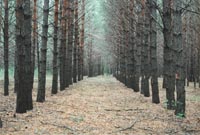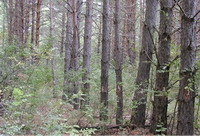


 |
|
 |
Rus/Eng |
|
||||||||||||
|
"Хвойные бореальной зоны" 2009г., №1, с. 22-28 Изучение грибов синевы древесины в хвойных лесах Центральной Сибири Пашенова Н.В.1, Полякова Г.Г.1, Афанасова Е.Н.2 1Институт леса им. В.Н.Сукачева СО РАН 2Красноярский Государственный Педагогический Университет им. В.П. Астафьева Приведены результаты многолетних исследований грибов синевы древесины, связанных с наиболее опасными насекомыми-вредителями стволов хвойных в Центральной Сибири. Было установлено, что эти грибы представляют типичный компонент микобиоты, обитающей в ходах насекомых-ксилофагов. Ходы насекомых под корой ослабленных и погибших деревьев являлись основным резервуаром офиостомовых грибов в исследованных лесах, и именно ксилофаги распространяли эти грибы, перенося споры на поверхности экзоскелета. Частота встречаемости грибов в ходах переносчиков варьировала от 50 до 100 %. Были идентифицированы грибы, принадлежащие к родам Ceratocystis Ellis& Halstead, Ceratocystiopsis Upad.& Kendrick, Grosmannia Goid., Ophiostoma H.and P. Syd. Среди них виды Ceratocystis laricicola Redfern&Minter, C. polonica (Siem.) C. Moreau, Grosmannia penicillata (Grosmann) Goid., O.minus (Hedgc.)H.&P.Syd., Ophiostoma sp., а также несовершенный гриб Leptographium sibirica Jacobs&Wingfield, sp.nov., могут приносить наибольший ущерб древостоям. Как было установлено, эти грибы способны развиваться даже во флоэме здоровых деревьев в случае искусственного их заражения. Они вызывали некрозы проводящих тканей с длиной 4 - 10 см и до 40 см в здоровых и ослабленных деревьях, соответственно. В условиях крупномасштабных вспышек численности насекомых-переносчиков, спровоцированных климатическими стрессами и техногенными загрязнениями, эти виды способны превратиться в важный фитопатогенный фактор. Ключевые слова: грибы синевы древесины, хвойные, насекомые-ксилофаги The results of the multi-year study of blue stain fungi associated with the most dangerous major conifer pest species in Central Siberia are reported. The fungi were found to be the typical mycobiota component in the galleries of xylophagous insects. The study revealed that the under-bark pest galleries served as the main fungi pools in the forests of interest and that it was xylophages who contributed greatly to the fungi spread by carrying the spores on their exoskeletons. The fungi occurrence was calculated to vary from 50 to 100 % in the vector galleries. The species of the genera Ceratocystis Ellis& Halstead, Ceratocystiopsis Upad.& Kendrick, Grosmannia Goid., Ophiostoma H.and P. Syd. were identified, among which Ceratocystis laricicola Redfern&Minter, C. polonica (Siem.) C. Moreau, Grosmannia penicillata (Grosmann) Goid., O.minus (Hedgc.)H.&P.Syd., Ophiostoma sp. as well as hyphomycetous fungus Leptographium sibirica Jacobs&Wingfield, sp.nov. appeared to have the highest pathogenic importance. These fungi were found to be capable to develop even in healthy tree phloem, when artificially inoculated there. They caused conducting woody tissue necrosis that extended 4-10 cm and up to 40 cm in healthy and weakened trees, respectively. These species are deemed to be particularly important, since they can contribute considerably to wood damage caused by large-scale vector outbreaks resulting from ecological stresses and industrial pollution. Key words: blue stain fungi, conifers, xylophagous insects БИБЛИОГРАФИЧЕСКИЙ СПИСОК Пашенова, Н.В. Офиостомовые грибы в ходах большого лиственничного короеда / Н.В. Пашенова, В.П. Ветрова, Р.М. Матренина, Е.Н. Сорокина // Лесоведение. – 1995. - .№ 6. – С. 62-68.
|
|||||||||||